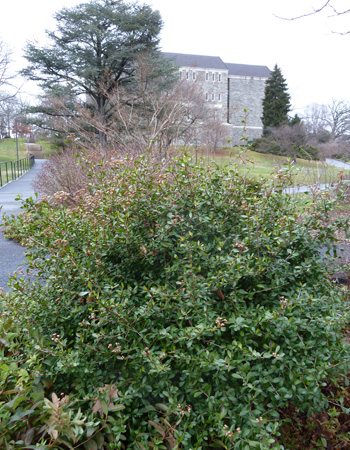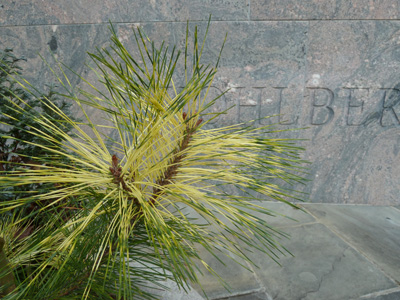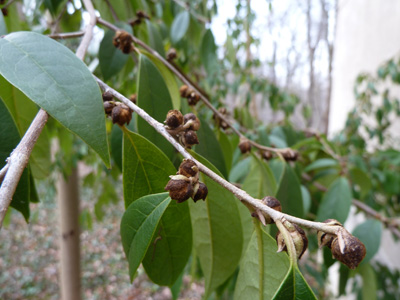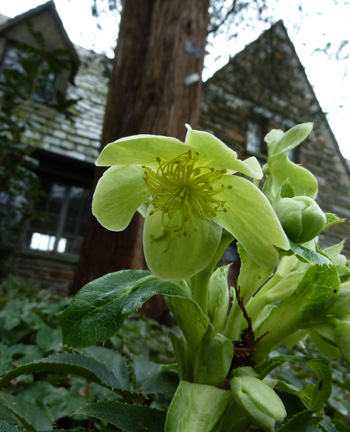Plants of the Week – January 14
 I had believed for over 2 years that a rounded shrub anchoring a planting near Old Tarble was an Ilex crenata. Then cymes of flowers appeared. The rounded evergreen shrub, approximately 3’ in height, was not a holly but Viburnum obovatum ‘Reifler’s Dwarf’. Viburnum obovatum is found from South Carolina to central Florida and Alabama. Walter’s or small leaf viburnum flowers profusely in full sun, though partial shade is tolerated. In the south, the species and selections are valued for hedging as the plant responds well to shearing. It’s curious and I’m uncertain why this specimen is blooming in January. Photo credit: J. Coceano
I had believed for over 2 years that a rounded shrub anchoring a planting near Old Tarble was an Ilex crenata. Then cymes of flowers appeared. The rounded evergreen shrub, approximately 3’ in height, was not a holly but Viburnum obovatum ‘Reifler’s Dwarf’. Viburnum obovatum is found from South Carolina to central Florida and Alabama. Walter’s or small leaf viburnum flowers profusely in full sun, though partial shade is tolerated. In the south, the species and selections are valued for hedging as the plant responds well to shearing. It’s curious and I’m uncertain why this specimen is blooming in January. Photo credit: J. Coceano
Sycopsis sinensis may not produce the degree of floral display possessed by its cousin, Hamamelis, (Hamemelis mollis ‘Early Bright’ is currently in full bloom) but other attributes make this plant a fascinating addition to the garden. Various forms exist ranging from loose shrubby habits to narrow tree forms. Evergreen leaves, 2 – 4” in length, hold their dark green color year-round. Yellow-green flowers with red anthers open in early spring. The Chinese fighazel has survived -10?F at the U.S. National Arboretum. Two are showcased at the Arboretum: one by the side entrance to Martin Hall near the Pollinator Garden and one near the Lang Music Building. Photo credit: J. Coceano
Helleborus argutifolius hails from the islands of Corsica and Sardinia. While locally widespread, it is not known to occur outside of the two islands. Flowers held above the foliage are pale green. The sepals reflex or curl backwards with age. Compared to other species and hybrids, Helleborus argutifolius is somewhat tender. Plants can withstand freezing temperatures, though prolonged periods of cold will damage foliage and stunt flowers. Plant in a protected location or along a south-facing façade. Photo credit: J. Coceano
 The dragon’s-eye pine, Pinus densiflora ‘Oculus draconis’ is aptly named for the alternate rings of yellow and green creating an eyeball effect when viewed from above. Blue Sterling Nursery lists the pine as an intermediate grower reaching 10’ in 10 years. A magnificent specimen can be seen in the pinetum at the Barton Arboretum and Nature Preserve at Medford Leas. Several young trees are featured in winter containers at the Scott Arboretum. Photo credit: J. Coceano
The dragon’s-eye pine, Pinus densiflora ‘Oculus draconis’ is aptly named for the alternate rings of yellow and green creating an eyeball effect when viewed from above. Blue Sterling Nursery lists the pine as an intermediate grower reaching 10’ in 10 years. A magnificent specimen can be seen in the pinetum at the Barton Arboretum and Nature Preserve at Medford Leas. Several young trees are featured in winter containers at the Scott Arboretum. Photo credit: J. Coceano







Warren A. Jacobs
Posted at 09:52h, 18 JanuaryI always chuckle a little when I see a plant cultivar that is grown for a trait that mimics
a pest or disease or elemental deficiency!